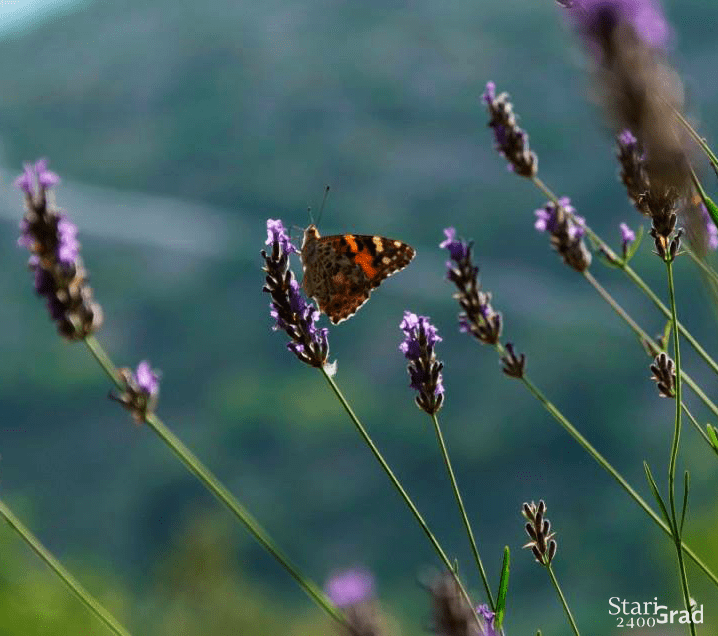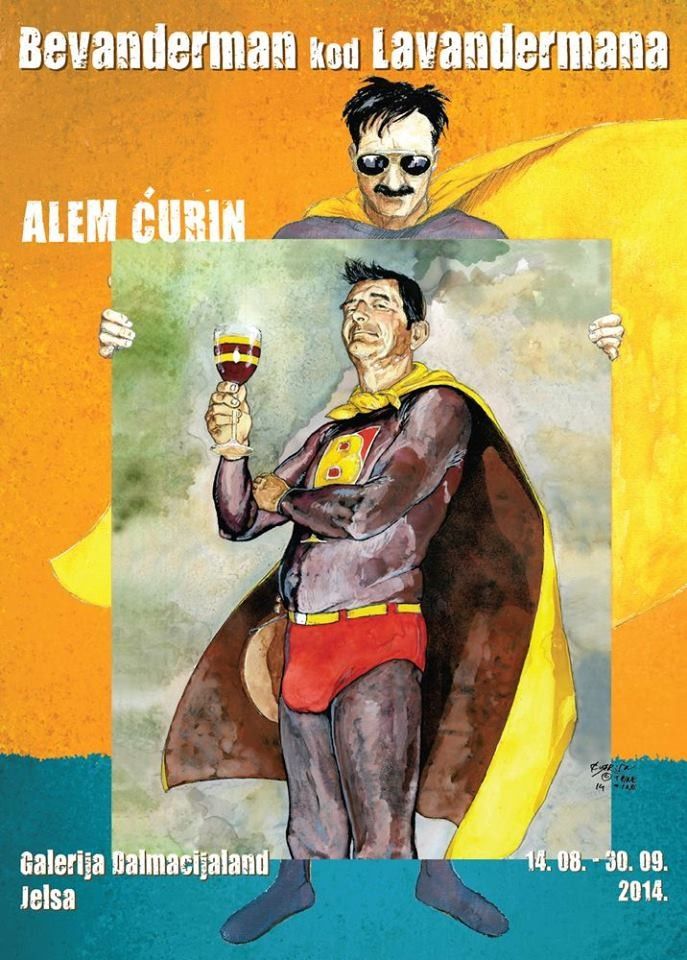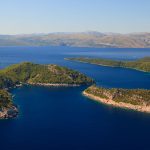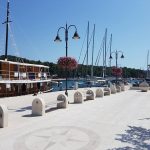Stari Grad on Hvar has been nominated for Best European Destination 2017. Continuing the popular 25 Things to Know about Croatia series on November 27, 2016, a closer look at one the town celebrating its 2400th birthday.

1 – The Meaning of Stari Grad
For the linguistically challenged, Stari Grad is a joy. Not only is is easy to pronounce, but its meaning is derived from two useful words. Stari means ‘old’ and Grad means ‘town’. There, you are almost fluent! And some people think learning Croatian is hard… And the town is old, of which more below. It used to be called Faros and was until relatively recently the capital of what we all know is the sunniest island in Europe.

2 – Not to be Confused with…
It is however not the only town in Croatia with the same name – given the number of old towns and the language lesson in point 1 above, this is perhaps understandable. There is another very popular destination on the mainland in northern Dalmatia called Starigrad Paklenica. And while both are beautiful, they are also a fair distance from each other. Make sure you are 100% sure which one you have booked before you get on the ferry. The number of people who turn up in Stari Grad asking for help finding accommodation they have booked in Starigrad Paklenica would surprise you…

3 – 2400 years, or Longer?
Many people call it the oldest town in Croatia. It is certainly one of the oldest. The Ancient Greeks from the island of Paros sailed in to Stari Grad’s deep bay in 384 BC and established the colony of Faros. That was exactly 2400 years ago, and there was quite a party to celebrate. The oldest town though? Conventional wisdom says that title goes to Issa, modern day Vis Town on the next island. But prior to the Greeks, it was an important trading station for the Liburnian confedaration, who got pushed out by the Greeks. On one thing we can agree, Stari Grad is OLD!
4 – UNESCO World Heritage Site
And while some empires rise and fall, the impact of the Ancient Greeks is very much still felt today. On arrival, they took control of a very fertile plain next to their new capital, dividing it into equal plots and introducing things for which Hvar is famous today – quality wine and quality olive oil. And 2400 years later, that fertile plain, nurtured by the Greeks, is one of Croatia’s eight UNESCO World Heritage Sites, the Stari Grad Plain. It is one of Hvar’s great untapped tourism jewels, and it only took me 8 years of living here to realise it exisited. Take a tour of the history in the video above.

5 – Paiz not Paris
Stari Grad to you, Paiz to the locals. Many place names on Hvar have a local dialect variation (my favourite being Zavala – Pitovska Plaza (literally Pitve Beach)), and Stari Grad is Paiz. It may sound like Paris, it may not look like Paris, but read on, for good times and properity are coming to this genuinely gorgeous town.
6 – Celebrity Visitors, from an Abdicating British King to a Waterskiing American President’s Wife
Hvar the celebrity island. While the visits of Bono, Tom Cruise and Demi Moore occupy the paparazzi these days, Stari Grad is the original celebrity heaven on Hvar. It is where Edward and Mrs Simpson popped in for lunch after he abdicated the British throne in 1936 (lunch at Jurin Podrum, still run by the same family), and where Mrs JFK came in to waterski, accompanied by a Yugoslav patrol boat.

7 – Legendary 100 Year-Old Fishing Net Repairman
But Stari Grad has its own celebrities, including this man, who has seen them come and seen them go. Andrija Petric Muse is one of the icons of Hvar, a quiet unassuming man who can be seen most days oppostite Pizzeria Marko mending nets, as he has done for generations. An avid smoker for more than 80 years, he celebrated his 100th birthday this year.
8 – Faros Marathon
Stari Grad is home to one of the most challenging international swimming races in the world, an annual event in August which attracts some of the globe’s finest swimmers, including Olympic gold medal winners. Started in 1974, the Faros Marathon is a 16km race in the open sea, starting and finishing in the town’s harbour, from where competitors race to the tip of the Kabal Peninsula at the top of the Stari Grad Bay – some 8km away – and back. A phenomenal physical effort for the increasingly international field, where the winner has yet to break three hours. Check out the race in the video above.
9 – The Amazing Plima Phenomenon
Ah, the deep Stari Grad Bay. It caused considerable distress to a poor dolphin, who inadvertantly swam into the harbour in 2005, and could not figure a way out for three days until expert help pointed the poor creature in the right drection. A scarier prospect for local residents is the ‘plima’, a raising of the water level cauased by particular climatic conditions and such a deep bay, which results in rapid rising of the water level. It is quite a spectacle to watch, as long as you are not a waterfront home owner. Check out the video below.

10 – Petar Hektorovic and the Tvrdalj
The top attraction in Stari Grad is the Hektorović Tvrdalj, the ‘castle’ built by one of Croaita’s most famous poets, Petar Hektorović (1487 – 1572). Situated at the back of the largest square in the town, close to the court, Hektorović built an original legacy, and carved pithy and witty sayings in stone around the building in Latin, Italian and Croatian. The entrance bears the inscription: “Petar Hectorović, son of Marino, at his own expense and by his own effort built this for the use of himself and his friends.”
With a long sea-facing wall preventing it from attack and intrusion, entering the courtyard is something of a surprise, and includes a large fishpool and herb garden. The main gardens have gradually been replanted over the last twenty-odd years with an astonishing variety of Mediterranean plants. Horses often graze in the paddocks alongside the gardens. There is a display of historical tools and agricultural equipment in an enclosed area to one side, and one can climb up a small tower nearby to look over the property. The house itself, which boasts one of the earliest indoor toilets in Europe, is not open to the public, but the gardens and fishpond are a delight to visit, especially in summer, when they are a refreshing oasis of shady peace to shelter in.
11 – Faroski Kantaduri
For such a small town (the permanent population was less than 1800 at the last census), Stari Grad has an incredibly vibrant cultural scene. In addition to several excellent museums, two theatres (and two fabulous amateur theatre groups) and a host of other cultural activities, the male voices of Stari Grad are known throughout the land, and if you ever get the chance to hear the Faros Kantaduri, don’t miss them. For a taster, check them out in the video above.

12 – New Marina
After years of stagnation, there has been a marked improvement in infrastructure in recent years, most notably the entending of the waterfront with a new riva at the top of the old town. Apart from being a picturesque addition to the town centre, the new waterfront has allowed a market increase in sailing traffic, and the potential for Stari Grad to push on and develop its nautical tourism is enticing indeed. Standing behind the new waterfront is arguably the best symbol of Stari Grad’s potential rise – Apolon, a high quality collection of boutique rooms and restaurant, which already has the informed luxury traveller relocating from Hvar Town.

13 – Four Seasons Hotels
Stari Grad is on the cusp of real change, which good easily thrust it into one of the best destinations on the Adriatic. The most exciting planned addition is the planned opening of the first Four Seasons Hotel in Croatia, a 120-room hotel and 60 villas just outside the town. Scheduled to open in 2019, it would be the most luxurious development on the Adriatic, yet one more string in Stari Grad’s increasingly impressive bow. In the picture above, Croatian President Kolinda Grabar Kitarovic is given a tour of the site in the hotel’s showroom in the temporary office at Apolon.
14 – Airport
It may not evoke comparisons with London Heathrow, but Stari Grad even has its own airport, located in the heart of the UNESCO World Heritage Site. Due to cultural considerations, the airport cannot be upgraded or expanded, but it does serve as a useful and convenient point for small aircraft and helicopters (the airstrip can accommodate planes of maximum six passengers), as well as providing a summer base for Hvar’s popular sky-diving offer.

15 – Lanterna for Lovers
Although Stari Grad is not famous for its beaches (there is PLENTY of competition on gorgeous Hvar), there are several reasonable beaches within walking distance, with an even better choice ten minutes by car. One of the most romantic places close by is Lanterna, a little further on from the old town, where locals go to swim, and also to get romantic, and I am sure that every Stari Grad resident – and many tourists – have a special romantic memory or three from this idyllic spot. The sunsets are fantastic.

16 – Wildflower Europe
Being located on Europe’s sunniest island with an enviable array of plant life, Stari Grad really is a natural paradise. It was perhaps why it was selected to be one of just five communities in Europe to take part in a special EU project celebrating nature in the community. The official website describes the project thus:
A unique project celebrating the cultural heritage of both our wildflowers and the rural communities which have helped to keep them as part of our landscapes. The project has three main elements – the Patchwork Meadow, annual wildflower festivals in Bulgaria, Croatia, Romania, Slovenia and Scotland, developing community history archives. Learn more from the official website.

17 – Pace of Life v Hvar Town
As the former capital, Stari Grad has been living in the shadows of Hvar Town for a long time now, but many of the locals like it that way. While most of the party tourism heads into Hvar Town, Stari Grad has a much more relaxed feel, and with its vast pedestrianised centre and old town, one can truly get lost in the back streets, wondering at more than 2,000 years of living history. But not too lost, for eventually, you will find the waterfront once more.
It is a very safe destination, and a great one for people wanting to experience the truly relaxed Dalmatian way – a throwback in time. It is also an outstanding base for families and there is plenty on offer for the little ones, including things such as theatre workshops, a guitar school and a sailing school for kids in recent years. Safe, relaxed, stunning.

18 – Kabal and Tito’s Tunnels
Just north of Stari Grad is the gorgeous Kabal Peninula, a natural heaven where where are only two permanent settlements and a few private houses in small idyllic bays. It is where a lot of the locals go to swim, a great way to escape the summer crowds. At the top of the peninsula, after 12km along a rough road, there is a painted sign for a tunnel on a large rock. Follow it to enter Tito’s Tunnels, a concrete construction carved into the rock at the entrance to the wide Stari Grad Bay. And follow them to come to the turret prepared for Yugoslav soldiers to defend the town from naval attack. You can see the tunnels as you come in on the ferry from Split, on the left hand side as you enter the bay, some 8km from the town. And if you do visit the tunnels, bring a picnic – the sunsets are sensational.
19 – Paprenjok
Starogrojski paprenjok is an original souvenir made as a homage to a traditional biscuit which the women and girls of Stari Grad on the Island of Hvar have lovingly prepared since 1167 for their sons and husbands, packing them in sailor’s chests before their loved ones’ departure on long and faraway journeys.
These cakes are prepared according to a carefully preserved recipe of the old island women and have retained the traditional shapes of amphora, fish, heart, clover and other imaginative forms lined with sweet stripes and playful dots.
The earliest mention of the famous cake from Stari Grad, Starogrojski paprenjok, was left by Petar Hektorović, in his famous poem, ‘Ribanje i ribarsko prigovaranje’, from 1556. The work is a description of a three-day fishing trip from Stari Grad to the island of Šolta and back. In it, the poet Petar Hektorović sailed in the company of two fishermen, Paskoje and Nikola. They took with them: good wine muškatil, sweet wine (prošek), turta (cake), honeycomb, kaškaval cheese, fruit and paprenakov.
The main ingredient for paprenjok is honey. In the castle, that is, in the flaunting park, the Hektorović family cultivated poultry, silkworms and bees.
Hektorović’s farmers cultivated wheat in the fertile Stari Grad fields; they milled it in the mill located in Tvrdalj. Another important ingredient was also olive oil. The Hektorović family’s olive groves were located in the southern part of the town.
To prepare a paprenjok they also needed prošek. Prošek was made from good quality grapes in the tavern in Tvrdalj.
The only thing which could not be cultivated in Tvrdalj were the aromatic herbs – cinnamon, cloves and nutmegs.
But in that period they were easily obtained, as the port of Stari Grad was located on the route between Venice, Dubrovnik and the numerous Mediterranean ports with which trade took place.
In Stari Grad cinnamon, cloves and nutmegs were, until the first half of the 20th century, known by the

20 – Lampedusa and the 150-Year Sardine Connection
Stari Grad has a proud sailing tradition, including some rather unusual features, including a strong connection with the island of Lampedusa, as explained by the local tourist board:
Around 150 years ago, Tomažo Bonaparte, a Hvar ship-owner, went looking for sardines and arrived on the Italian island of Lampedusa, not far from the African coast.
After they heard about the successful fishing there, other Hvar ship-owners followed in his footsteps in the years that followed. The sailboat fleet sailed to Lampedusa every year, until autumn 1905 when the last Hvar sailboat “Giorgio”, captained by Frano Maroević from Stari Grad returned to the island of Hvar. On Lampedusa, they organized sardine fishing, salted them and put them into wooden barrels transporting them in their ships to Black Sea ports and the eastern Mediterranean, where they sold them and returned to the island loaded mainly with corn. Some of them remained on Lampedusa and their descendants still live there.special name – papor. This gave the name of paprenjoki to these pastries.

21 – From Faros to Paros
And in 2003, a rather unusual expedition was organised to retrace the steps of the Ancient Greeks all those years ago – a voyage in a traditional sailboat, from ‘Faros to Paros’, Faros being the name the Greeks gave to what is today Stari Grad, close as it sounded to their native island of Paros. The voyage included taking gifts including vines and olive trees which had brought som much prosperity and goodness to the residents of Hvar, and which had originally come from Paros in 384 BC. There is a documentary on the journey (in Croatian) which you can watch here.

22 – Devolved Parliament: Ministry of Other People’s Affairs
Thought the seat of power was in Zagreb?
Welcome to the newly-formed Ministry of Other People’s Affairs, perhaps the first de-centralised ministry not based in Zagreb. Order yourself a rakija or bevanda at Bistro Kod Damira on the entrance of Stari Grad and join in the conversation.
“We worry about business which is not our own. Who was where and what were they doing, who was drunk, who earns what, who has caught fish, planted olives, picked grapes and who is sleeping with who.” explained Minister Damir Čavić.
Bistro Kod Damira, which is open all year, certainly attracts an eclectic crowd of Bohemians (and not so Bohemians), and is a favourite place for many locals and visitors alike. It is also superbly located as an observation and gossip point for such a ministry.

23 – The Ferry Terminal
Stari Grad is of course the main point of entrance to the island, with the main ferry terminal located close by. The terminal had been until relatively recently located in the town itself, but is now a comfortable one kilometre away, close enough to reach, while keeping all the traffic out of the town. In recent years, the terminal has expanded considerably from the couple of huts which used to offer limited services, to two shopping centres and a proper ticket office.
24 – Malo Misto
Stari Grad is perhaps best known in the minds of a sizable chunk of the population of former Yugoslavia as the location for the VERY popular show Malo Misto (Little Place), which characterised and satirised life in a small town in Dalmatia. Even with my limited ability to pick up the words of the actors, I find it wonderfully funny, and Stari Grad looks glorious. A sample episode is above.

25 – A Superhero to Rival Lavanderman – Bevanderman
And what would Europe’s potential top destination for 2017 be without its very own superhero? Neighbouring Jelsa has its famous superhero, Lavanderman, but the people of Stari Grad hit straight back, producing some pure genius in response – their very own Bevanderman. Who needs lavender, when you have endless supplies of bevanda, the Dalmatian drink of red wine watered down with regular water? Very popular locally, not one I have managed to get into yet, but I am still young.
Stari Grad. A truly fascinating small town with centuries of history and tradition and one of the best preserved old towns in all Croatia. A town with an incredibly exciting future, and one which if managed correctly, has the potential to rival and even surpass Hvar Town as a quality tourist destination in the coming years.










